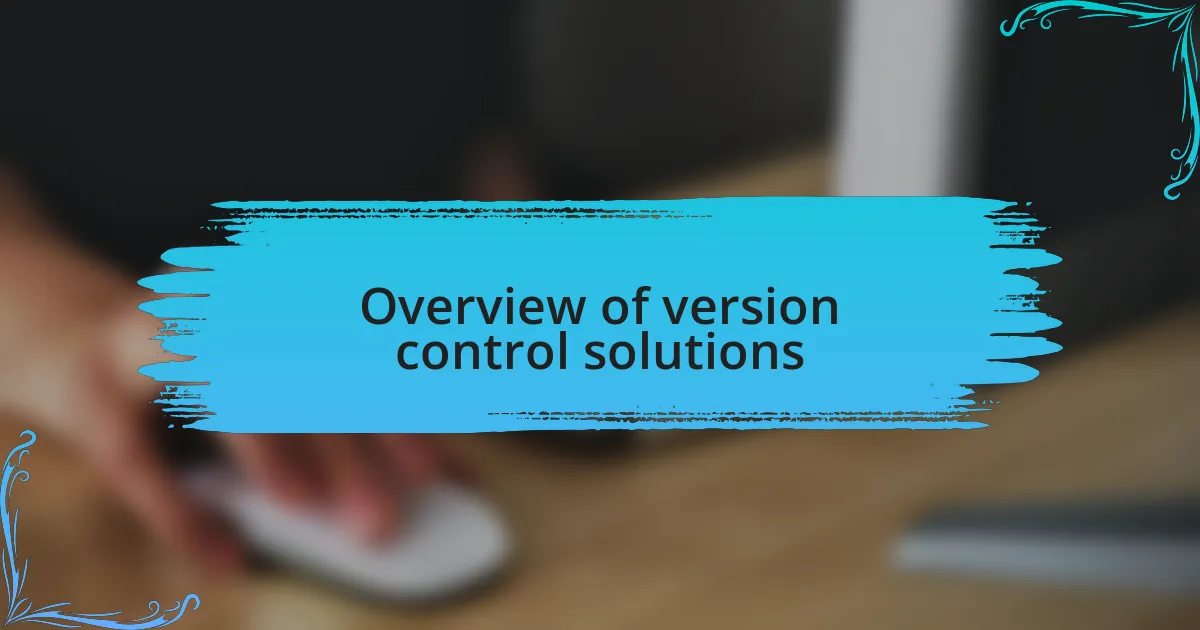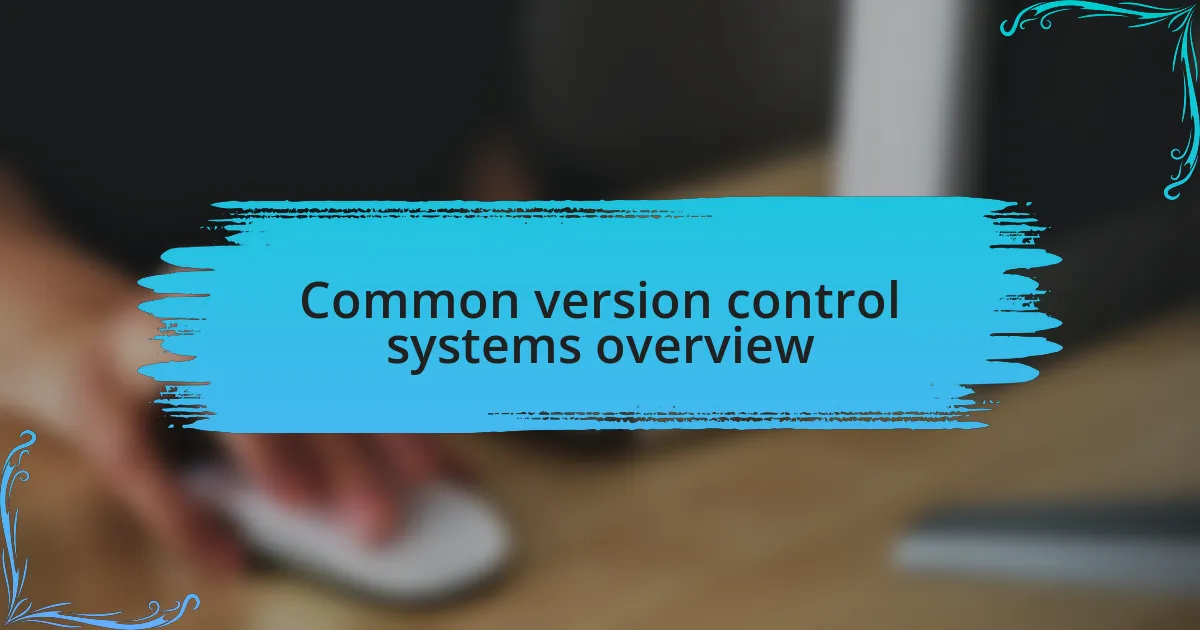Key takeaways:
- Version control systems, particularly distributed ones like Git, enhance collaboration and allow developers to manage codebase changes more effectively.
- Usability, integration with other tools, and cost-effectiveness are critical factors to consider when selecting a version control solution.
- Merge conflicts and the learning curve associated with version control can be significant challenges, emphasizing the need for communication and regular practice.
- Developing a habit of frequent commits helps maintain project progress and fosters accountability within teams.

Overview of version control solutions
Version control solutions are essential tools for any application developer, allowing teams to track changes, collaborate, and manage various versions of a codebase effortlessly. I still remember my first encounter with Git; the complexity of branching and merging was overwhelming yet exhilarating as I began to see its true power in managing my projects efficiently. How many times have you found yourself scrambling to remember what changes were made and why? This is where effective version control kicks in, transforming chaos into order.
There are various version control systems available today, ranging from centralized systems like Subversion to distributed solutions like Git and Mercurial. In my experience, I found switching from a centralized system to Git to be a game changer; the freedom to work offline and easily create branches helped me innovate without the pressure of affecting the main codebase right away. Can you imagine having the ability to experiment freely and revert back to the mainline without fear? That’s the beauty of distributed version control.
As I navigated through these options, I often pondered: what makes a version control system truly effective? The answer lies in its usability, collaboration capabilities, and how well it integrates with other tools in your development environment. I recall long nights spent wrestling with merge conflicts and wondering how I could have avoided the headache with better practices. Striking the right balance between power and simplicity is crucial in choosing the right version control solution for your needs.

Common version control systems overview
When exploring common version control systems, Git consistently stands out due to its robust features and widespread adoption. I was amazed by how Git’s branching system allowed me to experiment with new ideas without the fear of breaking existing code. Have you ever faced the daunting challenge of managing multiple features in development? With Git, managing these features through branches made it seem achievable and less intimidating.
Subversion (SVN) offers a contrasting approach with its centralized model, which I initially appreciated for its simplicity. However, I soon realized that this centralization could be limiting; any misstep could affect the entire team. Memories of waiting for approvals to access the main repository still haunt me. Does that sound familiar? While SVN has its advantages, the real-time collaboration often felt stifled compared to the freedoms provided by distributed systems like Git.
Mercurial is another option worth mentioning, though I found it to be less popular within the communities I worked in. It boasts an intuitive interface, yet I often felt compelled to gravitate back to Git for its extensive community support and the wealth of resources available. Have you ever started to prefer a tool simply because it felt like everyone else was using it? My journey through these systems has taught me that while the best tool is subjective, aligning it with your workflow can make a world of difference.

Evaluating version control tool options
When evaluating version control tool options, it’s essential to consider not only the features but also how they align with your workflow. For instance, I remember feeling overwhelmed by the myriad of choices when I first started. After some trial and error, I realized that a tool’s user interface can significantly impact my productivity. Have you ever chosen a tool simply because it looked appealing? It turns out that aesthetics and ease of use can genuinely enhance the development experience.
Beyond interface, I found that integration capabilities played a crucial role. I once struggled with a version control system that didn’t seamlessly connect with my project management tools. The disconnect led to unnecessary confusion and extra work. Looking back, I understand that a tool’s ability to integrate with other software could save time and reduce frustration. Have you assessed how well a version control system can work alongside your existing tools? It can make all the difference in your team’s efficiency.
Cost is another factor that can’t be ignored. The first time I had to choose a version control solution for a small startup, I felt a heavy weight on my shoulders. I wanted to ensure we were investing wisely without sacrificing essential features. There’s nothing like the anxiety of choosing the right tool with limited resources at play. Have you experienced this pressure? I learned that a balance between cost and capability is crucial, and sometimes open-source solutions can provide the flexibility needed without breaking the bank.

Personal challenges with version control
Navigating version control systems has presented me with my share of bumps in the road. In particular, I remember the frustration of merging branches, especially when conflicting changes arose. It felt like a high-stakes puzzle, with every decision affecting my team’s progress. Have you ever experienced merge conflicts that seemed to take forever to resolve? Those tense moments taught me the importance of consistent communication within my team to prevent conflicts from escalating.
I also grappled with the learning curve associated with some version control tools. There were days when I felt lost in the array of commands and features, leading to a sense of inadequacy. I vividly recall sitting in front of my screen, re-reading documentation for hours, wondering if I was ever going to get the hang of it. Have you felt that sense of being overwhelmed when trying to learn a new system? I realized that seeking help from peers and utilizing online communities made all the difference, transforming what seemed like a daunting task into a more manageable learning experience.
Another challenge I’ve faced is the discipline required for regularly committing changes. In the early days, I’d often forget to commit my work until the end of a development sprint, which led to a frantic rush at deadlines. Have you ever experienced that last-minute scramble? I’ve learned the hard way that developing a habit of committing frequently not only keeps my progress tracked but also helps in fostering accountability to myself and the team, ultimately creating a smoother workflow.